|

Can't keep a good dog down: The Golden Retriever should be athletic, well balanced, and symmetrical. They are slightly longer than high. Its appearance should reflect its merry and outgoing temperament, and it should never look sulky or aggressive. This is a large breed very similar in appearance to the yellow Labrador Retriever, especially when young. The most obvious difference is the Golden Retriever's luxuriant coat.
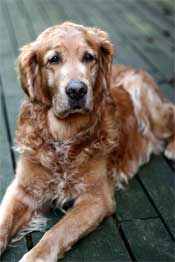 Waterproof Vest : The coat should be dense and waterproof,
and may be straight or moderately wavy. It
should not be silky, hard, or wooly. It must Waterproof Vest : The coat should be dense and waterproof,
and may be straight or moderately wavy. It
should not be silky, hard, or wooly. It must
lie flat against the body. The AKC standard states that the coat is a "rich, lustrous golden of
various shades", disallowing coats that are extremely light or extremely dark. This leaves
the outer ranges of coat color up to a judge's discretion when competing in conformation shows. Judges may also disallow Goldens with brown
or pink noses, though these are very rare. The Golden's coat can also be what people call a 'mahogany' color, or what people see as
'redheads' in people. As a Golden grows older
their coats can become darker shades or lighter
tints of brown, along with or excluding a noticeable whitening of the fur on and around the face.
Young at Heart : Golden Retrievers reach their full height around one year of age and full weight around age two, though many owners comment that their dogs retain their puppyish nature for life. They are 22-24 ins at the withers for males, and 20-22 ins for females. Males weigh 65-75 lb, and females about 60-70 lb.

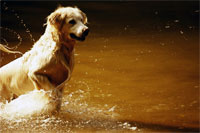 Everybody loves a clown: Goldens are active and fun-loving but also exceptionally patient, as befits a dog bred to sit quietly for hours in a hunting blind. Other characteristics related to their hunting heritage are a size suited for scrambling in and out of boats and an inordinate love for cool water. They are noted for their affection for people, and their tolerance of children. They are natural clowns, which characterizes them as great therapy dogs to use in hospitals or retirement homes. Most Goldens require lots of companionship to be happy. Due to their intelligence, they do well in obedience trials and make excellent assistance dogs. While they might not do quite as well in field trials as Labrador Retrievers, they are excellent hunters, famous for their outstanding scenting abilities. However, many Golden Retrievers will not express their desire to "fetch" until adulthood. Everybody loves a clown: Goldens are active and fun-loving but also exceptionally patient, as befits a dog bred to sit quietly for hours in a hunting blind. Other characteristics related to their hunting heritage are a size suited for scrambling in and out of boats and an inordinate love for cool water. They are noted for their affection for people, and their tolerance of children. They are natural clowns, which characterizes them as great therapy dogs to use in hospitals or retirement homes. Most Goldens require lots of companionship to be happy. Due to their intelligence, they do well in obedience trials and make excellent assistance dogs. While they might not do quite as well in field trials as Labrador Retrievers, they are excellent hunters, famous for their outstanding scenting abilities. However, many Golden Retrievers will not express their desire to "fetch" until adulthood.
What's in a name: The Golden Retriever loves to retrieve. Retrieving a thrown stick, tennis ball, or flying disc can keep a Golden occupied and entertained for hours, particularly if there is also water involved.
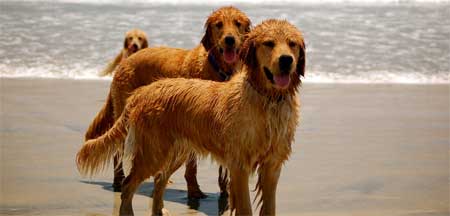
All work, and no play: Today's Golden Retrievers fall into two groups: show dogs and field dogs. The Goldens in the show group are generally bigger boned, longer, and heavier. The champagne color and long flowing coat are highly prized in the show ring. On the other hand, field Goldens tend to be smaller, longer legged, and have a more reddish shade. These two strains derive from famous Goldens from the 1960s. Presently, many breeders are attempting to unite these two strains into the all-purpose Golden Retriever.

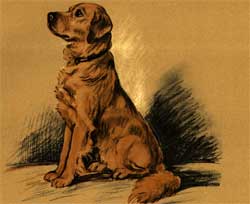 A born Highlander: The breed was originally developed in Scotland, at "Guisachan", near Glen Affric, the highland estate of Sir Dudley Majoribanks, later Lord Tweedmouth. For many years, there was controversy over which breeds were originally crossed; especially popular was a romantic story concerning the purchase of a whole troupe of Russian sheepdogs from a visiting circus. In 1952, the
publication of Majoribanks' breeding records from 1835 to 1890 removed all doubt. A born Highlander: The breed was originally developed in Scotland, at "Guisachan", near Glen Affric, the highland estate of Sir Dudley Majoribanks, later Lord Tweedmouth. For many years, there was controversy over which breeds were originally crossed; especially popular was a romantic story concerning the purchase of a whole troupe of Russian sheepdogs from a visiting circus. In 1952, the
publication of Majoribanks' breeding records from 1835 to 1890 removed all doubt.
A Sporting Pedigree: The original cross was of a yellow-colored dog, Nous, with a Tweed Water Spaniel bitch, Belle. The Tweed Water Spaniel is now extinct but was then common in the border country. Majoribanks had purchased Nous in 1865 from an unregistered litter of otherwise black wavy-coated Retriever pups. In 1868, this cross produced a litter that included four bitch pups. These four became the basis of a breeding program which included Red Setter, sandy-colored Bloodhound, St. John's Water Dog of Newfoundland, Springer Spaniel, and two more wavy-coated black Retrievers. The bloodline was also inbred and selected for trueness to Majoribanks' idea of the ultimate hunting dog. This vision included a more vigorous and powerful dog than previous retrievers but that would still be exceptionally good with people and thus gentle and trainable. Russian sheepdogs are not mentioned in these records, nor are any other working dog breeds. The ancestry of the Golden Retriever is all sporting dogs, in line with Majoribanks' goals.
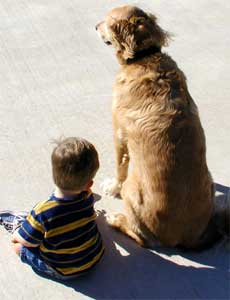 Golden Retrievers were first accepted for registration by the The Kennel Club of England in 1903, as 'Flat Coats - Golden'. They were first exhibited in 1908, and in 1911 were recognized as a breed described as 'Retriever (Golden and Yellow)'. In 1913, the Golden Retriever Club was founded. The breed name was officially changed to Golden Retriever in 1920. Golden Retrievers were first accepted for registration by the The Kennel Club of England in 1903, as 'Flat Coats - Golden'. They were first exhibited in 1908, and in 1911 were recognized as a breed described as 'Retriever (Golden and Yellow)'. In 1913, the Golden Retriever Club was founded. The breed name was officially changed to Golden Retriever in 1920.
The Hon. Archie Majoribanks took a Golden Retriever to Canada in 1881, and registered Lady with the American Kennel Club in 1894. These are the first records of the breed in these two countries. The breed was first registered in Canada in 1927, and the Golden Retriever Club of Canada was formed in 1958.
The AKC recognized the breed in 1932, and in 1938 the Golden Retriever Club of America was formed.
Keep a careful eye: Goldens are often very profitable to breeders, including puppy mills and backyard breeders. As a result of careless breeding for profit they are prone to many diseases, both genetic and otherwise. Hip dysplasia is very common in the breed, and when buying a puppy make sure its parents have healthy hips and have been examined by either the OFA or PennHIP.
All text is available under the terms
of the GNU Free Documentation License
|
